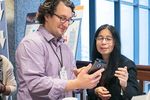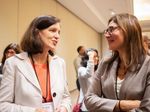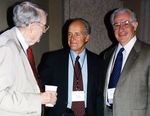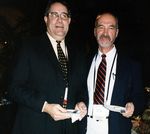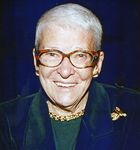"W" is for Wash U - Child Neurology Society
←
→
Page content transcription
If your browser does not render page correctly, please read the page content below
"W" is for Wash U As it happens, "W" is also for “What if?” That, of course, is the baseline question with which every exercise in counterfactual history begins. A classic in the genre, posed by Winston Churchill in a 1931 essay, is “What if Lee had not lost at Gettysburg?” For my generation, the Baby Boomers, the classic, counterfactual question, posed with added poignance this past week following news that Sirhan Sirhan may be released from prison on parole, is “What if Robert Kennedy had not been assassinated in 1968?” Raising that “What if?” question strikes me as being as good of an approach as any to writing a brief appreciation of Washington University’s contributions to child neurology and the Child Neurology Society. The key word is “brief.” How, after all, could anyone summarize in five or six paragraphs the central, irreplaceable role the program at Wash U has played in the development of child neurology and the CNS over the past five decades? It can’t be done. I won’t even try. The best way, then, of not foolishly trying, may be to briefly engage in a bit of counterfactual history: What if Phil Dodge had not turned his back on the Charles River in Boston and moved west to St. Louis, on the banks of the Mississippi River? What if, in consequence, there being no Wash U program to lure them, no Phil Dodge to inspire and mentor them, the trio of Darryl De Vivo, Marvin Fishman and Joseph Volpe had not gone into child neurology, opting instead to do research in Parkinson’s Disease or neonatal cardiology? Who would have served as CNS President in 6 of the 8 years stretching from 1987-1995 and how different would the arc of history between then and now have been in consequence? But, even before then, what of the entire decade of the 80s during which time they each served as Councillors for the Midwest on the Executive Committee, as did their Wash U colleague, Ed Dodson (1985-87), recipient in 2019 of the Roger & Mary Brumback Lifetime Achievement Award (presented by CNS President, Jon Mink, himself a Wash U alum)? Or, going back further, to the Founding Decade of the 1970s, what subtle changes of vector might have occurred had Phil Dodge’s towering partner, Arthur Prensky not served as
Councillor on he Executive Committee from 1975-77 and as CNS President in 1978-79? Would we even have thought about holding the CNS Annual Meeting in St. Louis in 2000, and presenting Art Prensky the Hower Award and Joe Volpe the Sachs Award at that meeting? Not likely. Suppose we travel north to pose a set of counterfactual questions from the distant perch of the 2004 CNS Annual Meeting in Ottawa: What would that meeting have looked and felt like had it not been the occasion of renaming the Lifetime Achievement after Phil Dodge, with Phil present to be honored? Or had Terri Inder not been present to receive the newly renamed award Dodge Young Investigator Award? What if Jean Holowach Thurston had not been present the day before to receive the first-ever CNS Lifetime Achievement Award? And what of the diaspora of other colleagues and trainees (too numerous to be mentioned or shown here) who passed through the program and left St. Louis with its inimitable imprint on them? It would make for a great variation on that other parlor game, "Six Degrees of Separation". Are there any members of the CNS whose careers and lives have not been shaped in some way, large or small, through meaningful contact one or two degrees removed from one or more Wash U programs or alumni? An epic version of the counterfactual history parlor game could be played using the photo below that I have previously and playfully dubbed “All the Young Dudes”. It might look, at first glance, like the movie poster for the 1982 film, Diner, (which included "Mr. Six Degrees," himself, Kevin Bacon). But, it’s actually a photo taken five years later of a remarkable cadre of smiling, and surprisingly well-coifed, residents and fellows at Wash U. Four of them won Young Investigator Awards before it was renamed in Phil Dodge’s honor: Scott Pomeroy (1989), Ken Mack (1991), Kel Yamada (1992), and Jeff Neil (1993). Steve Leber moved north from St. Louis to Ann Arbor (and an arguably better football program), serving on the CNS Executive Committee from 2007- 09, and later as Secretary-treasurer of the Professors of Child Neurology. He was the 2nd recipient, in 2014, of the CNS-PCN Training Director Award. That award was the brainchild of Gary Clark. As program chief at Baylor/Texas Children’s Hospital, Councillor for the South on the CNS Executive Committee (2010-12) and President of the PCN (2013-15), Gary first proposed the award and got funding for it from the Blue Bird Circle at his home institution.
What about all the lives those estimable “young dudes” went on to touch, the careers in child neurology and neurodevelopmental pediatrics they launched and shaped over the next 30+ years? Would Christopher Smyser have taken the stage to give the Dodge Young Investigator Award Lecture in 2014 had he not been mentored by Jeff Neil, who introduced him? Let us not forget, before moving on, the shaping influence during the "young dudes" collective tenure at Wash U of Mike Noetzel, who was elected to serve on the CNS Executive Committee from 2001- 03. And how do we even begin to measure the contributions that will be made in child neurology in the next 30 years as a result of 2003 Young Investigator Awardee, Brad Schlaggar’s seminal role in nurturing an entire emerging generation of child neurologists through his direction of the Child Neurology Career Development Project (CNCDP) and the program at Kennedy Krieger Institute? What would the field of child neurology and the Child Neurology Society be like if the pathways taken through life by all those dudes, young and old, had not passed through Wash U? What would it – what will it – look like had those admirably brilliant white males not been succeeded by a cadre of equally brilliant, but significantly more diverse child neurologists? That cadre includes, but is hardly limited to Soe Mar (currently serving on the PECN Board of Directors), Laura Jansen (2008 Dodge Young Investigator Awardee and current Chair of the CNS Awards Committee), Bhooma Avaramuthan (first recipient of the Post-Graduate Outstanding Junior Member Award in 2018 and organizer and presenter of not one, but two symposia staged at the upcoming CNS Annual Meeting in Boston), and Christina Gurnett (Division Director at Wash U and faculty member with the CNCDP, shown below at the CNCDP retreat coincident with the 2018 CNS Annual Meeting in Chicago).
I will close with the biggest “What if?” of all: what would the future of child neurology and the CNS
look like without all those in the current Wash U program pictured below and posted on their
website? What would their future, and so our future, look like without the training, teaching and
practice skills modeled and passed on to them by Christina Gurnett (Division Chief), Soe Mar
(Residency Program Director), Rejean Guerriero (Associate Residency Program Director) and
Sarah Bauer Huang (Associate Program Director)? How can one begin to answer that huge
unthinkably huge and overwhelming "What if?"
Thankfully, we don’t have to.
Until Tuesday, September 7 (yes, friends, I am taking the Labor Day weekend off)
Roger
Roger Larson, CAE
Executive Director
On-line Registration is Open! 2021 CNS 50th Annual Meeting
Registration is now open for the long For more information, click button below.
awaited 50th Golden Anniversary Meeting
of the Child Neurology Society in Boston.
Registrants attending this milestone Click for More Info
meeting live and in-person in Boston will
want to register early (some sessions are
limited and reservation-only). You will also
want to book hotel rooms ASAP. A link and
access code to the Sheraton Boston Hotel
will be included in your registration
confirmation email.
Click to
RegisterYou can also read




